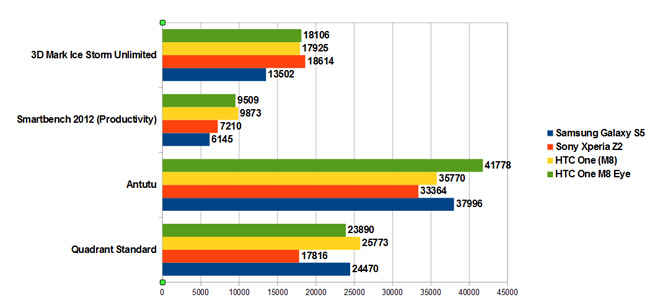HTC One M8 Eye Review : Not much of an upgrade
The HTC One M8 Eye doesn't offer anything new apart from the new 13MP dual-lens camera. However it still comes with the elegant metal body, a great touchscreen display and a powerful performance package. The updated camera doesn't impress as the overall quality is the same apart from the resolution. A worthy update? Nope. However, this was probably what HTC should have launched as the original One M8.
Display: 5 inches Super LCD3, 1920×1080 resolution with Gorilla Glass 3 (441ppi)
Battery: 2600mAh
Storage: 16GB
Camera: 13MP dual-lens rear with dual-tone flash, 5MP front
SoC: Qualcomm Snapdragon 801
CPU: Quad-core 2.5 GHz
GPU: Adreno 330
RAM: 2GB
Operating system: Android 4.4.2 with Sense 6
Connectivity: 3G, Wi-Fi, Bluetooth, USB with OTG
BODY AND DESIGN
The HTC One M8 Eye is exactly the same smartphone as the original M8 except for the dual-13MP lenses. If you put both the handsets together, one can not tell the difference. You get the same elegant metal body carved to perfection and the same brilliant looking 5-inch Super LCD3 display with full HD resolution. It even weighs the same at 160gms which is fairly decent considering the all-metal body.
The right side has the volume control keys and the nanoSIM card slot, the left side has a slot for a microSD card which supports cards up to 128GB, the top has the power/lock key while the bottom has the 3.5mm audio jack and the microUSB port. The back has a full metal finish with an updated 13MP dual-lens with a dual-tone flash.
There is no update in the design of the One M8 Eye when compared to the One M8. The finishing and materials used are exactly the same, which still makes it the best looking phone in the market. HTC has smartly used the great design of the M8 and has started launching different versions of the handset. Whether this strategy will help the company with its flagging numbers is a story time will tell.
UI AND PERFORMANCE
The HTC One M8 Eye runs on Android 4.4.4 with Sense 6 which is really stable and fluid. The UI works well and scrolling through menus is silky smooth and there are no glitches or stutters anywhere. The minimalistic and flat design of Sense UI feels great. There are a few bloatware apps which hog the internal memory, but there arealso a few apps which are quite useful at times.
Blinkfeed, as usual, is available to the left of the homescreen and we've come to adore it. It acts as a hub for all your social media as well as news in a simple tiled format. Sense UI has matured over time and is now one of the most stable UIs that we have seen and it definitely complements a premium smartphone like the One M8 Eye.
Performance on the M8 Eye surprised us as it turned out to be better than the M8. In terms of benchmarks, there was a significant improvement although overall the performance seems quite similar to the M8. It seems that HTC has tuned up the Snapdragon 801 chip and certainly improved on the OS. Check out the the benchmark scores below:
In terms of battery life, the M8 Eye gives almost a full day of charge on normal usage. I case of heavy usage where you play a lot of games, use the camera, listen to music, it lasts about half a day.
CAMERA
The only update to the smartphone is in the camera where HTC has gone ahead and put a 13MP dual-lens system which sounds quite exciting on paper. The camera app looks quite similar to the previous app that we have seen on the One M8 and E8 with some slight updates. You now get new modes including Split Capture, Crop-Me-In, Photo Booth and Pan 360 apart from the front and back camera modes.
You get your usual filters, effects and, of course, the vast editing options including the re-focusing, 3D, stickers, seasons, face fusion, etc. You also get manual controls while shooting just like the M8. The only downside is that most of the editing tools work only when you shoot a properly lit picture. Pictures shot in low light or macro mode cannot be post processed with the camera editor.
Just like the M8, the camera on the M8 Eye is fast and the tap to exposure feature is impressive. The colour reproduction has just the right amount of saturation and contrast. In low-light, the performance is decent, although for a flagship camera smartphone, we expected it to be better. Under dim-light, you can see noise in certain pictures.
So does the upgrade to a higher resolution camera make a difference? Nope. The picture quality seems similar to the original M8. Since the sensor is the same, and we presume the optics as well, the overall quality has not improved. Yes, you now get a higher resolution image, but with the same quality.
Check out the camera sample below:
CONCLUSION
The HTC One M8 Eye is hardly an update from the M8. If HTC claims that the M8 Eye offers a better camera than the original M8, we beg to differ. For the price, the M8 Eye is great phone, but we would also suggest the HTC One E8, Samsung Galaxy S5 or even the Moto X 2nd Gen.





